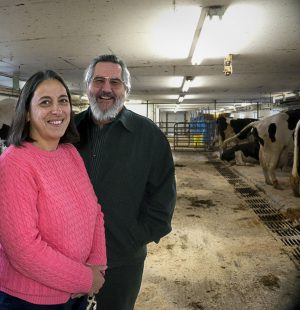Mobile technology to bring the latest research into the heart of dairy production

A Michigan State University College of Veterinary Medicine researcher will lead a multidisciplinary, multi-institutional effort to adapt mobile technology to help farmers prevent dairy cattle illness.
Lorraine Sordillo, Meadow Brook Chair of Farm Animal Health and Well-being, has received a nearly $1 million grant from the U.S. Department of Agriculture for the four-year project. Researchers from MSU and North Dakota State University will study the factors that contribute to cow health risks during the most vulnerable period of their lives—the three weeks before and the first several weeks after giving birth. Data will be collected to develop an app for smartphones, tablet computers and other mobile devices that can detect early warning signs of disease susceptibility.
"Cows can get sick anytime, but they're especially vulnerable during the transition phase—when they're switching from late pregnancy to producing milk after the calf is born," says Sordillo, who is also an MSU AgBioResearch animal scientist. "The big problem is that if a cow gets sick during the early lactation period, she'll never reach her peak milk-producing capacity."
Dairy cattle are particularly susceptible at this time and can suffer from metabolic stress due to the tremendous energy requirements for birth of the calf and then milk production. This can result in a compromised immune system and the development of various diseases.
The factors that contribute to metabolic stress, called biomarkers, can be monitored and are well-documented as a result of years of research. Sordillo said she and her team plan to take advantage of modern mobile technology in an effort to compile that knowledge into a tool that farmers can use in the field.
Currently, most farms have to address the causes of metabolic stress after the animals are already sick. Sordillo and her team want to be able to provide farmers with proactive tools to prevent disease from occurring.
"We want all cows to be healthy," she said. "We want to utilize the biomarkers that we already know are effective warning signs and put them into a user-friendly tool so farmers will be able to manage their herds for metabolic stress before illnesses become a problem. We're trying to translate what we already know from research into a practical field application."
MSU researchers involved in the project include Sordillo, Bo Norby, and Andres Contreras from the Department of Large Animal Clinical Sciences; Robert Malinowski, director of the College's Center for Academic Technologies; and Rubén Martinez, professor of sociology and director of the Julian Samora Research Institute at MSU. The team will develop the app to allow farmers to input a series of variables to calculate the risk of metabolic stress and then recommend adjustments to prevent it. With the ability to enter individual data that captures unique features of the farm environment—such as herd size, sources of feed, cow housing and climate—the app will be customizable with repeated use.
The researchers will also use the app to help train the next generation of food animal veterinarians and on-farm consultants.
"They're the boots on the ground dealing with animal health issues, and we want to make sure our trainees have the latest and greatest tools to do their jobs well," Sordillo said. "We also need it to be user-friendly for other farm personnel who may not have the advanced medical training of a vet because, if you have to spend weeks or months learning how to use it, you just won't. We're designing it to appeal to people in the industry of all levels of education and experience."
Sordillo said the team will refine the list of biomarkers for metabolic stress that are most accurate in detecting increased risk of disease during early lactation, incorporate them into the app and test for effectiveness on dairy herds in Michigan.
"This is not long-term research—this will have an immediate impact on the industry," Sordillo said. "At the end of the four years, we'll have a new tool that will be able to integrate with other management tools that are already commercially available and improve the way we manage dairy production and cow health."
June 11, 2014
